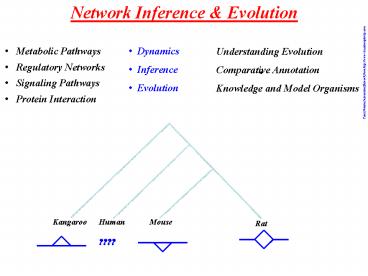Network Inference - PowerPoint PPT Presentation
1 / 16
Title:
Network Inference
Description:
Yeast Protein Interaction Network from http://www.visualcomplexity.com Dynamics Inference Evolution Understanding Evolution Comparative Annotation – PowerPoint PPT presentation
Number of Views:79
Avg rating:3.0/5.0
Title: Network Inference
1
Network Inference Evolution
- Dynamics
- Inference
- Evolution
- Understanding Evolution
- Comparative Annotation
- Knowledge and Model Organisms
- Metabolic Pathways
- Regulatory Networks
- Signaling Pathways
- Protein Interaction
Yeast Protein Interaction Network from
http//www.visualcomplexity.com
Kangaroo
Human
Mouse
Rat
????
2
Networks ? A Cell ? A Human
- What happened to the missing 36 orders of
magnitude???
- Which approximations have been made?
A Spatial homogeneity ? 103-107 molecules can be
represented by concentration 104
B One molecule (104), one action per second
(1015)
1019
C Little explicit description beyond the cell
1013
A Compartmentalisation can be added, some models
(ie Turing) create spatial heterogeneity
B Hopefully valid, but hard to test
C Techniques (ie medical imaging) gather beyond
cell data
3
A repertoire of Dynamic Network Models
To get to networks No space heterogeneity
? molecules are represented by numbers/concentrati
ons
Definition of Biochemical Network
- Description of dynamics for each rule.
Discrete Deterministic the reactions are
applied.
Boolean only 0/1 values.
Stochastic Discrete the reaction fires after
exponential with some intensity I(X1,X2) updating
the number of molecules Continuous the
concentrations fluctuate according to a diffusion
process.
4
Boolean Networks
Remade from Somogyi Sniegoski,96. F2
5
Boolean functions, Wiring Diagrams and
Trajectories
Remade from Somogyi Sniegoski,96. F4
6
Boolean Networks R.Somogyi CA Sniegoski (1996)
Modelling the Complexity of Genetic Networks
Complexity 1.6.45-64.
Contradiction Always turned off (biological
meaningless) Tautology Always turned on
(household genes)
7
BOOL-1 Reveal
If O(22k2k alog(n)) INPUT patterns are given
uniformly randomly, BOOL-1 correctly identifies
the underlying network with probability 1-n-a,
where a is any fixed real number gt 1.
Dhaeseler et al.(2000) Genetic network
Inference from co-expression clustering to
reverse engineering. Bioinformatics Akutsu et al.
(2000) Inferring qualitative relations in genetic
networks and metabolic pathways. Bioinformatics
16.2.727- 16.8.707-
- 50 genes
- Random firing rules
- Thus network inference is easy.
- However, it is not
8
Gaussian Processes
Definition A Stochastic Process X(t) is a GP if
all finite sets of time points, t1,t2,..,tk,
defines stochastic variable that follows a
multivariate Normal distribution, N(m,S), where m
is the k-dimensional mean and S is the kk
dimensional covariance matrix.
Examples Brownian Motion All increments are
N( ,Dt) distributed. Dt is the time period for
the increment. No equilibrium distribution.
Ornstein-Uhlenbeck Process diffusion process
with centralizing linear drift. N( , ) as
equilibrium distribution.
One TF (transcription factor black ball) (f(t))
whose concentration fluctuates over times
influence k genes (xj) (four in this
illustration) through their TFBS (transcription
factor binding site - blue). The strength of its
influence is described through a gene specific
sensitivity, Sj. Dj decay of gene j, Bj
production of gene j in absence of TF
9
Gaussian Processes
Gaussian Processes are characterized by their
mean and variances thus calculating these for xj
and f at pairs of time, t and t, points is a key
objective
Rattray, Lawrence et al. Manchester
This defines a prior on the observables
Then observe
and a posterior distribution is defined
10
Gaussian Processes
Relevant Generalizations
Non-linear response function
Multiple transcription factors
Network relationship between genes
Observations in Multiple Species
Comments Inference of Hidden Processes has
strong similarity to genome annotation
11
Development of Network/Sequence Analysis
1960
1980
1970
1990
2000
biological sequence comparison
biological network comparison
1990
2002
2001
2004
2010
2005
2003
Sharan and Ideker, 2006
12
Stochastic Modeling of Network Evolution
Only topology of networks will be considered.
I.e. dynamics and continuous parameters often
ignored.
Yeast Protein Interaction Network from
http//www.visualcomplexity.com
13
Likelihood of Homologous Pathways
14
A Model for the Evolution of Metabolisms
- A given set of possible reactions -
- arrows not shown.
- A set of present reactions - M
- black and red arrows
- Let m be the rate of deletion
- l the rate of insertion
- Then
15
P(N1--gtN2) and Corner Cutting
If d(N1,N2) k, then there are 2k networks are
visitable on shortest paths. If 2? additional
steps are allowed, then 2k (L L(L-1)/2
(L(L-1)..(L-?1)/?!) are visitable.
Example. 15 nodes, L105, ?t?t0.05, ? 2, d4.
P(4) e-.5.54/4!.003 P(6) e-.5.56/6!lt10-4
Olle Haegstroem (2002) Finite Markov Chains and
Algorithmic Applications, Cambridge University
Press Lyngsø R, Y.S.Song and J.J.Hein (2008)
Accurate Computation of Likelihoods in the
Coalescent with Recombination via Parsimony In
press Recomb
16
Evolving Networks MCMC
- Metropolis-Hasting integrating of all paths -
Green (1995) version
Green, P. J. (1995) Reversible jump Markov chain
Monte Carlo computation and Bayesian model
determination, Biometrika, 82, 711-732































